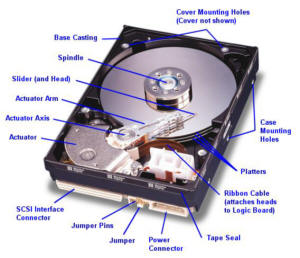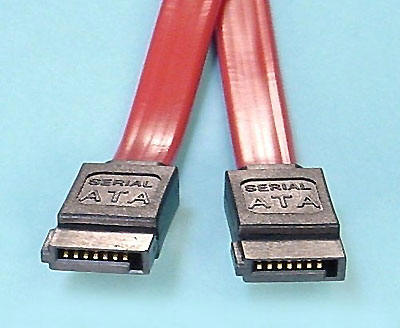|
Serial ATA is basically a replacement for IDE which we have been using now for about 20 years. IDE and EIDE were developed for desktop machines mostly, to allow them to have high data capacity and data rates to the internal storage systems. They did a superb job, lets face it with Apple & co coming round to the idea from SCSI because of the fantastic value for money. IDE has used ATA (Advanced Technology Architecture) in it's parallel form (PATA) and the SATA systems are using the serial form.
|

|
|
SCSI disks are often seen as too expensive for smaller servers with the advent of SATA-600
|
| |
Serial ATA (SATA) brings easier installations because the cables are smaller and there is no longer any requirement for Master/Slave configuration.
As well as this the data rates are faster and the communication the disk makes with the interface has been improved. Data rates for SATA are 300 and 600 MB/sec at both the disk and interface.
|
| |

|
| |
Serial ATA connector - significantly smaller.
|
About Serial ATA
Industry leaders including Intel, Seagate, Maxtor, Dell, APT Technologies designed Serial ATA. This group is known as the Serial ATA working group and includes over 80 companies. This innovative interface is designed to overcome the limitations of Parallel ATA and replace it which it is doing as we speak.
Serial ATA offers consumers a new level of interface scalable performance, flexibility, and cost efficiency. Industry leaders designed Serial ATA with customer convenience in mind by ensuring 100% software compatibility, flexible thin cables, hot plug connectors, and improved data reliability and protection.
With a maximum external (burst) data transfer speed of 300 MB per second, Serial ATA improves hard drive performance to keep pace with increasing data intensive environments such as audio/video, consumer electronics and entry-level servers. The new drives appearing Q4 2005 SATA-II drives allow transfer speeds of 600 MB per second.
What is the difference between SATA I, SATA II and SATA III?
The SATA I (revision 1.x) interface, formally known as SATA 1.5Gb/s or SATA-150, is the first generation SATA interface running at 1.5 Gb/s. Somewhat confusingly, the throughput supported by the interface, is up to a maximum of 150MBs per second.
The SATA II (revision 2.x) interface, formally known as SATA 3Gb/s or SATA-300, is a second generation SATA interface running at 3.0 Gb/s. The throughput supported by the interface, is maxes out at 300MB/s.
SATA III (revision 3.x) interface, formally known as SATA 6Gb/s or SATA-600, is a third generation SATA interface running at 6.0Gb/s. This system supports throughput of up to 600MB/s. This interface is backwards compatible with SATA 3 Gb/s hardware.
Each incarnation of the SATA system supports backward compatibility to its predecessors but the maximum speed of the drive will be slower due to the lower speed limitations of the port.
An SSD disk supporting SATA-600 interface connected to a SATA-600 port, can reach speeds of up to 550/520MB/s sequential read and write rates respectively. But if the drive was connected to SATA-300 port, it could only reach speeds of up to 285/275MB/s sequential read and write rates.
|